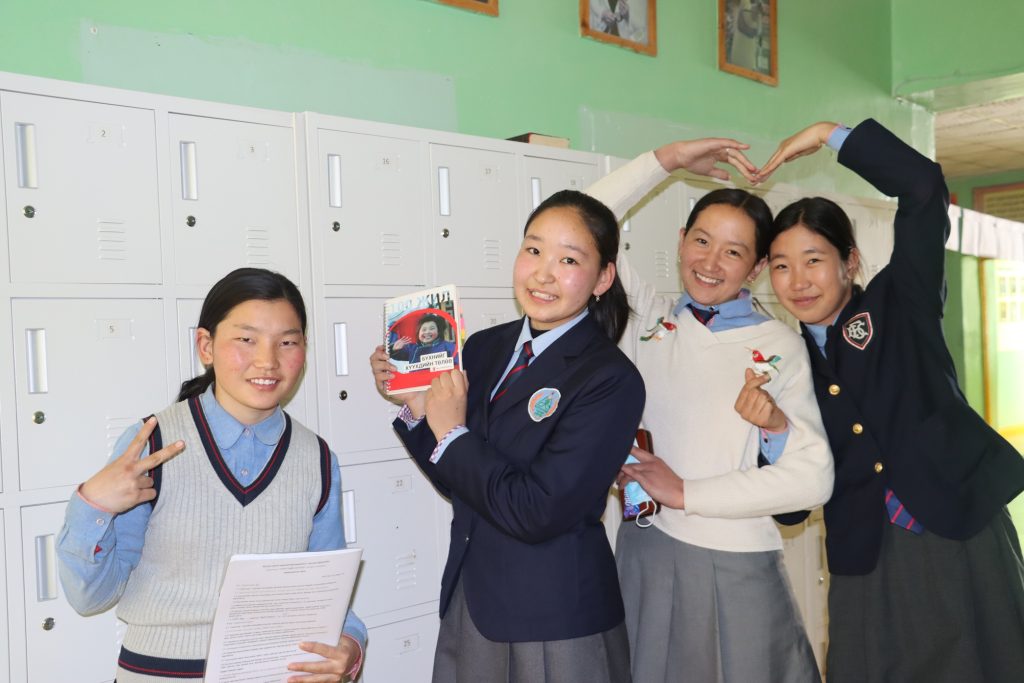“Student Locker” Project Lightens the Load

The “Rainbow of Success” team is a prime example of the achievements and success of the “Entrepreneurship-Focused Socio-Emotional Skills for the Most Vulnerable Youth in Rural Mongolia” project, implemented by Save the Children. In Bulgan soum, Khovd province, 11th and 12th grade graduates of the ESEL program formed a team and proposed the “Student Locker” project. Their idea, which involved providing a designated space for students to store their school bags, won the subgrant competition held in December 2021, earning them funding to bring their project to life.
Let’s introduce the members of the “Rainbow of Success” team: Team leader E.Anujin, along with E.Khaliun and B.Uyanga (all 11th grade students at the general secondary school in Bulgan soum, Khovd province), and U.Bold (a 12th grade student from the same school).
Team leader E.Anujin shared, “There is no public transport in our soum, and 25-30% of the students walk 2.5 to 4.5 kilometers to school. We noticed that carrying heavy school bags over such long distances negatively impacts students’ health. According to standards, the weight of a bag for children aged 14-18 should not exceed four kilograms, but in reality, the average weight of our students’ bags is 5-7 kilograms. Before starting the project, we assessed the risk of back pain caused by carrying these heavy bags. That’s when we decided to propose the ‘Student’s Locker’ project. Through this initiative, we aim to rent lockers to students at an affordable annual rate, and use the rental income to purchase additional lockers so that every student has one.”
-Where did you first hear about the training? What were your expectations before the training?
B.Uyanga: “I first heard about the personal skills development course through my class chat. At first, I didn’t fully understand what it was, and since it was right before the Lunar New Year, I was quite busy. But I decided to register with my parents. I was very shy and had trouble expressing my thoughts clearly to others. It felt encouraging to think that I could develop my personal skills and transform myself. Later, when I got more details from my teacher, I initially thought it was similar to The Apprentice. But as I got more involved, I realized it was more like Shark Tank.” /laughs/

E.Khaliun: “At the time, I was in the hospital, so my father went and filled out the application for me. When the teacher announced the selected students, I was so happy to see my name on the list. I saw the personal skills development training as a great opportunity.”
-How did you manage your time during the training?
E.Khaliun: “Sometimes, Anujin and I would attend the sessions in turns, and then explain the lessons we missed to each other and do our homework together.”
E.Anujin: “At first, my family was curious as to why I had to go back to school every day. Once I explained the reason and told them about the project, they became supportive. After school, once I finished my homework, I would go to ESEL training. If you manage your time effectively, you can accomplish almost anything.”
-How did you come up with the idea for your project? Can you share the story of how you wrote your proposal?
E.Khaliun: “During the training, we were placed in different teams. At that time, there were many project ideas, but we ended up focusing on the ‘Student’s Locker’ project. Our teacher suggested we choose it, and we agreed. We spent a week gathering information and then began drafting our proposal using the proposal writing manual from the textbook. We spent a lot of phone credit calling companies that sold lockers to help us come up with a business plan.” /laughs/
B.Uyanga: “It took a lot of time to conduct a survey asking high school students if they needed lockers and whether they found it difficult to carry heavy bags, but it was definitely worth it. On Pitch Day, our team went up together, and Anujin, our team leader, presented our project.”
E.Anujin: “The judges asked, ‘Can you show me the bag you brought to school today?’ So, I showed them the bag of a child sitting nearby. It was incredibly heavy. I said, ‘High school students have 5-6 hours of classes a day. They need to carry textbooks and notebooks. If they have a physical education class, they also need to bring training clothes and sports shoes.’ Then, all the students in the hall applauded and supported us. That’s when our project proposal was selected, and we received funding.”
What obstacles did you encounter?
E.Anujin: “During the training, I had to go back and forth to school for five days a week. It was a bit challenging to balance school lessons and ESEL classes while managing the project. The project itself was tough too. At first, I prepared the rental contracts. When the students came to rent a locker, I had them read the contract, sign it, and gave them the keys. But later, I realized I hadn’t recorded important details like which class they were from or which locker number they had. So, our team went around to each class, found the students who had rented lockers, and wrote down all the necessary information, including their class and gender. Then, we spent an entire day organizing the locker rental records. It was a big lesson for us.”
What new things did you learn at the training?
E.Anujin: “I learned how to express my opinions and ideas clearly. I really liked that the training used new textbooks and innovative methodologies. The parts on mapping, teamwork, and presentations were all so new and engaging for me. I especially enjoyed the ‘Time Management’ lesson. The guest teacher showed his notebook with his time plan, and now I keep my own notebook to plan my time just like he does.”
E.Khaliun: “I recognized the faces of other students, but I couldn’t communicate openly with them before. Now, I make an effort to talk to others, get to know them, and learn from them. I had never used the computer lab outside of class before. During the project proposal writing, I learned how to work more productively online, searching for images and gathering information. I’m also learning how to work in a team. Our team leader, Anujin, has a positive influence on us and is a great leader. We are all growing individually and learning from each other.”
B.Uyanga: “Before, only a few children knew me, but now they greet me with ‘Hello,’ respect me, and want to become my friend. The course was innovative and not part of the regular school curriculum. It was encouraging to have everything we needed. I especially enjoyed the drawing part of the training.”

What kind of person do you want to be in the future? Share your goals.
B.Uyanga: “I think I will study finance and business. The process of writing the project proposal was really exciting, and it felt even better when our proposal was selected. This project marked the first step in my career in the business field, and it felt like success was just beginning. While I don’t feel fully satisfied with myself because I think my contribution to the project’s success was small, I’m happy that I was able to assist during the implementation stage. For example, I helped present the project and handed out keys to the new locker renters. Sorting out all those keys and signing contracts was a lot of work. After the project was implemented, I felt a little unsure whether this sector was the right one for me. I wanted to explore other fields as well, but I’m glad that I gained experience and knowledge in business before I decide on my profession.”
E.Anujin: “I will actively participate in future project proposal competitions and programs because I’ve come to understand that every idea presented holds significant value.”
E.Khaliun: “I want to study medical science. When applying for scholarships to study abroad, they often ask if I have certificates from programs outside of school. Attaching the certificates I earned from this project was a huge advantage and helped me qualify for the scholarship. After completing grade 12, I’ll choose a country to study in and begin language training. This experience has been a major investment in my future.”
E.Anujin: “I would like to express my gratitude to my school teachers for their continuous support and guidance while we were developing the project proposal, to my family for understanding and supporting me by relieving me of housework, and to my brothers and sisters at Save the Children Mongolia, the World Bank, and the Japan Social Development Fund for giving us this wonderful opportunity.”

